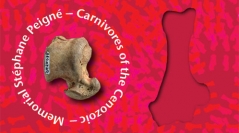

 Geodiversitas
42 (18) - Pages 305-325
Geodiversitas
42 (18) - Pages 305-325The Paleogene mammals of Europe are rarely known from partial or complete skeletons. As a result, their systematics and ecology are often solely based on dental characters and postcranial remains, when available, are usually neglected. This explains why the locomotion of mammals of the Eocene-Oligocene transition, the “Grande Coupure”, is poorly known. The aim of this study is to describe the tarsal bones (astragali and calcanei) and characterize the locomotion of amphicyonid carnivorans, one of the most abundant mammalian predator groups from the Phosphorites du Quercy (France) sites. The identification of taxa and the characterization of both posture and locomotion were carried out using four criteria: relative abundance (in comparison with dental data), morphology, size, and body mass. Seven morphotypes, four among astragali and three among calcanei, are identified as Amphicyonidae and show various postures: plantigrade, semi-digitigrade, and digitigrade. One morphotype of the astragalus and one of the calcaneus are identified as Cynodictis lacustris Gervais, 1852, which exhibits a digitigrade posture. The study of postcranial bones, such as tarsals, allows for a better understanding of the ecology of these animals and deserves more interest in future morphological and phylogenetic studies.
Caniformia, Quercy, France, Eocene, Oligocene, Diet, Posture, Locomotion